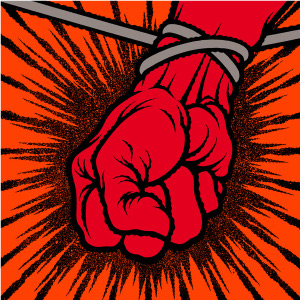
Superman is a fictional character, a superhero appearing in American comic books published by DC Comics. Created by writer Jerry Siegel and artist Joe Shuster, the character first appeared in Action Comics #1 on April 18, 1938 which marked the rise of the Golden Age of Comic Books.

A superhero is a type of heroic stock character, usually possessing supernatural or superhuman powers, who is dedicated to fighting the evil of their universe, protecting the public, and usually battling supervillains. A female superhero is sometimes called a superheroine, although the word superhero is also commonly used for females. Superhero fiction is the genre of fiction that is centered on such characters, especially in American comic book and films since the 1930s.

The Silver Age of Comic Books was a period of artistic advancement and widespread commercial success in mainstream American comic books, predominantly those featuring the superhero archetype. Following the Golden Age of Comic Books and an interregnum in the early to mid-1950s, the Silver Age is considered to cover the period from 1956 to circa 1970, and was succeeded by the Bronze and Modern Ages.
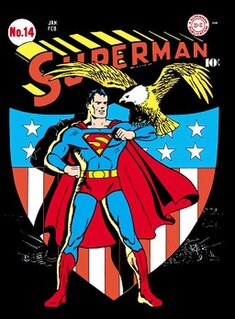
The Golden Age of Comic Books describes an era of American comic books from the late 1930s to circa 1950. During this time, modern comic books were first published and rapidly increased in popularity. The superhero archetype was created and many well-known characters were introduced, including Superman, Batman, Captain Marvel, Captain America, and Wonder Woman.
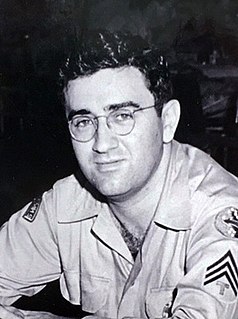
Jerome Siegel, who also used pseudonyms including Joe Carter and Jerry Ess, was an American comic book writer. His most famous creation was DC Comics character Superman, which he created in collaboration with his friend Joe Shuster.
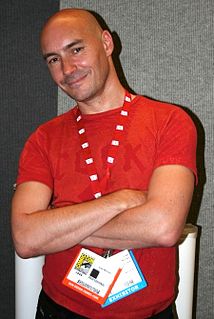
Grant Morrison, MBE is a Scottish comic book writer and playwright. He is known for his nonlinear narratives and countercultural leanings in his runs on titles including DC Comics's Animal Man, Batman, JLA, Action Comics, All-Star Superman, Vertigo's The Invisibles, and Fleetway's 2000 AD. He is the current editor-in-chief of Heavy Metal. He is also the co-creator of the Syfy TV series Happy! starring Christopher Meloni and Patton Oswalt.
Kid Eternity is a fictional character, a comic book superhero that premiered in Hit Comics #25 written by Otto Binder, drawn by Sheldon Moldoff, and published by Quality Comics in December 1942. All of Quality's intellectual properties were sold to DC Comics in 1956, including the character. The character has continued to appear in DC comic books since his revival in the 1970s.
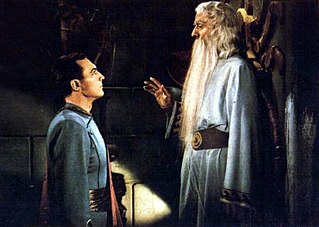
A superhero film, superhero movie, or superhero motion picture is a film that is focused on the actions of one or more superheroes: individuals who usually possess superhuman abilities relative to a normal person and are dedicated to protecting the public. These films typically feature action, adventure, fantasy or science fiction elements, with the first film of a particular character often including a focus on the origin of their special powers and their first confrontation with their most famous supervillain or archenemy.

Gear is a fictional character a superhero in the DC Comics universe. The character is a member of the Legion of Super-Heroes in the future.
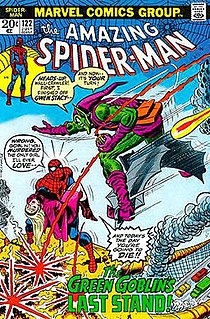
The Bronze Age of Comic Books is an informal name for a period in the history of American superhero comic books usually said to run from 1970 to 1985. It follows the Silver Age of Comic Books, and is followed by the Modern Age of Comic Books.
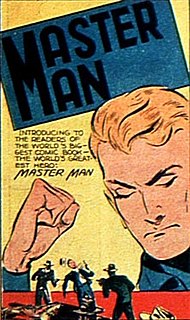
Master Man is a fictional character created during the 1930s to 1940s period historians and fans called the Golden Age of Comic Books. A superhero, the character's exact creator is uncertain: his first story, in 'Fawcett Comics' Master Comics #1, was drawn by Newt Alfred, but that issue's cover was drawn by Harry Fiske. The leader character in the anthology Master Comics, he was described as
...the world's greatest hero: Master Man! Stronger than untamed horses! Swifter than raging winds! Braver than mighty lions! Wiser than wisdom, kind as Galahad is Master Man, the wonder of the world! As a boy, young Master Man was weak until a wise old doctor gave the youth a magic capsule, full of vitamins, containing every source of energy known to man! The boy becomes the strongest man on earth! Upon the highest mountain peak he built a solid castle made of solid rock! From there he sees all evil in the world and races to destroy it instantly!
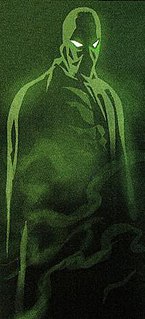
The Invisible Hood is a fictional superhero in the DC Comics Universe. He was originally owned by Quality Comics, but was later acquired by DC Comics, along with other Quality characters. He first appeared in Smash Comics #1, and was created by Art Pinajian, Pinajian illustrated the story under the pseudonym "Art Gordon".
The portrayal of Women in American comic books have often been the subject of controversy since the medium's beginning. Critics have noted the roles of women as both supporting characters and lead characters are substantially more subjected to gender stereotypes, with femininity and or sexual characteristics having a larger presence in their overall character.
Impala is a fictional character, a comic book superhero published by DC Comics. He first appeared in Super Friends #7, and was created by E. Nelson Bridwell and Ramona Fradon.

Superhero fiction is a genre of speculative fiction examining the adventures, personalities and ethics of costumed crime fighters known as superheroes, who often possess superhuman powers and battle similarly powered criminals known as supervillains. The genre primarily falls between hard fantasy and soft science fiction spectrum of scientific realism. Superhero fiction originated from the cultural intermingling of Japan and United States literature. It is most commonly associated with American comic books, though it has expanded into other media through adaptations and original works.

Superhero comics are one of the most common genres of American comic books. The genre rose to prominence in the 1930s and became extremely popular in the 1940s and has remained the dominant form of comic book in North America since the 1960s. Superhero comics feature stories about superheroes and the universes these characters inhabit.
DC Nation Shorts are animated shorts featuring characters from DC Comics that aired in a series on Cartoon Network on Saturdays at 10/9c.

Christopher A. Jones is an American comic book artist living in Minneapolis, Minnesota. He contributes artwork for DC Comics' Young Justice (2011-2013), based on the animated TV series of the same name & written by Greg Weisman, and Marvel's Avengers: Earth's Mightiest Heroes (2012–present), based on the animated TV series of the same name & written by Christopher Yost. Christopher Jones has previously contributed art to The Batman Strikes! (2004-2008), is the co-creator of Dr. Blink Superhero Shrink and has drawn various projects for DC, Marvel, Disney, and other publishers, ranging from kids' titles such as Superhero Squad to horror titles such as Re-Animator.
